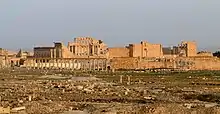History of the Arabs
The recorded history of the Arabs begins in the mid-9th century BCE, which is the earliest known attestation of the Old Arabic language. Tradition holds that Arabs descend from Ishmael, the son of Abraham.[1] The Syrian Desert is the home of the first attested "Arab" groups,[2][3] as well other Arab groups that spread in the land and existed for millennia.[4]
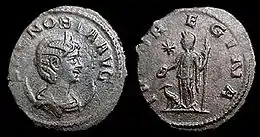
Before the expansion of the Rashidun Caliphate (632–661), "Arab" referred to any of the largely nomadic or settled Arabic tribes from the Arabian Peninsula, Syrian Desert, North and Lower Mesopotamia.[5] Today, "Arab" refers to a variety of large numbers of people whose native regions form the Arab world due to the spread of Arabs and the Arabic language throughout the region during the early Muslim conquests of the 7th and 8th centuries.[6] The Arabs forged the Rashidun (632–661), Umayyad (661–750) and the Abbasid (750–1258) caliphates, creating one of the largest land empires in history[7] reaching southern France in the west, China in the east, Anatolia in the north, and Sudan in the south. In 1517, the Mamluk Sultanate was conquered by the Ottoman Empire, which ruled much of the Arab world. In First World War, it was defeated and dissolved,[8] and its territories were partitioned, forming the modern Arab states.[9] After the adoption of the Alexandria Protocol in 1944, the Arab League was founded on 22 March 1945.[10] The Charter of the Arab League endorsed the principle of an Arab homeland while respecting the individual sovereignty of its member states.[11]
Antiquity
Iron age
Arabs are first mentioned in Biblical and Assyrian texts of the 9th to 5th centuries BC where they inhabited parts of present-day Syria, Saudi Arabia, Jordan, Lebanon and Iraq.[12] Several Arab tribes and towns are identified during the Neo-Assyrian period through their onomastics and toponyms. These tribes were present throughout Mesopotamia and the Syrian Desert, and in many times their presence often accompanied Aramean tribes.[13] In the land of Laqē near Terqa, which was mentioned in a inscription by Adad-nirari II (911–891 BC), Aramaean and Arab clans formed a confederacy.[13]
When Shalmaneser III descended on Pattin in 858 BC, he fought a force which included two Arab chieftains from transhumant tribes of the lower Orontes valley: a certain Bur-'Anat of Yašbuq, and Hada[d-ya]ṯa of a tribe whose name is lost.[13] In the Battle of Qarqar in 853 BC, Arabs were part of a Damascene coalition of Syrian and Israelite allies under Gindibu, who ruled over an Arab kingdom located in the northeastern parts of present-day Jordan and Wadi Sirhan. In the reign of Tiglath-Pileser III (744–727 BC), the "Arabāy" (Arabs) were among the Syrians integrated into the Assyrian administrative system, and were reportedly located in the regions of Damascus, Tadmor and Homs.[14][15] Tiglath-Pileser III even appointed a certain Arab, Idibi'ilu, to the Sinai peninsula jurisdiction.[13] Arab raiders were also active in the Beqaa Valley, where they attacked Sargon II's (722–705 BC) troops.[13][15]
A reference to the potential ancestors of Nabataeans, the Nabayatu, is made in a Babylonian letter from before 648 BC.[16] The Nabaytau reportedly lived in the Babylonian border region, and were probably the namesake of the city of Nabatu mentioned in an inscription of Marduk-apla-iddina II (721–710 BC).[13][15] During the campaigns of Ashurbanipal (669–631 BC) most Nabayatu clans shifted to the Syrian Desert, and by the 6th century had migrated to the area south of Wadi Sirhan.[13] Ashurbanipal launched a punitive campaign against the Arabs in Hauran from his base in Damascus, capturing Abiyate the Qedarite and taking him to Assyria.[15]
Classical kingdoms
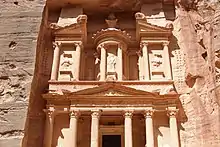
Ancient North Arabian texts give a clearer picture of Arabic's developmental history and emergence. Ancient North Arabian is a collection of texts from Jordan, Saudi Arabia and Syria which not only recorded ancient forms of Arabic, such as Safaitic and Hismaic, but also of pre-Arabic languages previously spoken in the Arabian peninsula, such as Dadanitic, Hasaitic and Taymanitic.[17] The texts are either written in variants or closely related sister scripts of epigraphic south Arabian musnad.
Nabataeans
The Nabataeans were nomads who moved into territory vacated by the Edomites – Semitic-speakers who settled the region centuries before them. Their early inscriptions were in Aramaic but gradually switched to their spoken Nabataean Arabic, thus producing some of the earliest clear Arabic texts. The Nabataean alphabet was adopted by Arabs to the south, and evolved into modern Arabic script around the 4th century. This is attested by Safaitic inscriptions (beginning in the 1st century BC) and the many Arabic personal names in Nabataean inscriptions. From about the 2nd century BC, a few inscriptions from Qaryat al-Faw reveal a dialect no longer considered proto-Arabic, but pre-classical Arabic. Five Syriac inscriptions mentioning Arabs have been found at Sumatar Harabesi northeast of Harran, one of which dates to the 2nd century AD.
In Syria
Arabs are first recorded in Palmyra in the late first millennium BC.[18] The soldiers of the sheikh Zabdibel, who aided the Seleucids in the battle of Raphia (217 BC), were described as Arabs; Zabdibel and his men were not actually identified as Palmyrenes in the texts, but the name "Zabdibel" is a Palmyrene name leading to the conclusion that the sheikh hailed from Palmyra.[18] After the Battle of Edessa in 260 CE, the Roman emperor Valerian was taken prisoner. Assuming the side of Rome, the Palmyrenes united under Odaenathus and defeated the Sassanian armies in several battles, even reaching the capital city, Ctesiphon, twice.
Odaenathus' son Vaballathus succeeded him in 270 under the regency of his mother Zenobia, who declared the Palmyrene Empire, quickly capturing most of the Near East, including Egypt and most of Asia Minor in 271, reaching Ancyra. Zenobia was defeatd by Aurelian with the help of the Arab enemies of Zenobia, the Tanukhids. The Tanukhids initially appear in 196 CE as a federation of Arab tribes roaming the western banks of the Euphrates who later made way into central and northern Syria, where they became part of the foederati of the Romans. They rebelled against Roman authority in 378 CE under their queen, Mavia, who lead her forces into Palestine, Arabia and even the edges of Egypt, and also served as auxiliaries in the Roman army.
South of the Taurus range and in the region of Antioch were an Arab group ruled by a certain Aziz, who played an important role in the affairs of the last Seleucid king Antiochus XIII Asiaticus. To the east of Antioch was another Arab group that ruled in Chalcidice represented by the Rhambaei, Gambarus and Themella, who were ruled by way of various Arab princes, including a famous Alchaedamnus who fought against Tigranes and in Caesar's civil war. Another Arab group or community was established in the Orontes river valley, the Emesene Arabs who dominated Emesa and Aresutha until the 2nd century, and were involved in the affairs of late Seleucid monarchs under their chief Sempsigeramus. In al-Zabadani region close by the Qalamoun Mountains, was an Arab group known as the Zabadaioi who came into conflict with Alexander Jannaeus (103–76 BCE).[19]
The Itureans, another Arab group known since Alexander the Great, inhabited the Bekaa valley, Southern Lebanon and the Anti-Lebanon mountains, and from there they expanded their territories into the Phoenician coast, Aurinitis, Trachonitis and Batanaea, coming close to Damascus.[20] In southern Palestine, the Idumaeans inhabited and became numerous in the area west of the Dead Sea, whose names comprised an admixture of Arabic and Canaanite names.[21]
Arabs were also living in Egypt even in pre-Christian times, in the Ptolemaic nome called Arabia, in Arsinoites across the Nile, and in Thebaid.[21]
In Mesopotamia

Further north, the Osroeni Arabs were in possession of the city of Edessa which they had occupied and ruled since the 2nd century BC, and which they had continued to rule until the 3rd century CE. The Kingdom of Hatra was similarly ruled by an Arab dynasty since the 2nd century CE, whose rulers assumed the title malka often in form of "King of the Arabs".[22][23] The Osroeni and Hatrans were part of several Arab groups or communities in upper Mesopotamia, who also included the Praetavi of Singara (present-day Sinjar, Iraq) reported by Pliny the Elder, and the Arabs of Adiabene. This elaborate Arab presence in upper Mesopotamia was acknowledged by the Sasanians, who called the region Arbayistan, meaning "land of the Arabs".[24]
Late kingdoms

Several Arab entities flourished during middle and late Antiquity, these included kingdoms and confederations of tribes that dominated large swaths of land in the Arabian Peninsula, Levant and Mesopotamia.
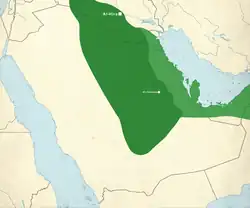
In central Arabia and Iraq, the Lakhmids assumed leadership from the Tanukhids and established themselves as clients for the Sasanians by 300 CE, ruling from their capital city of Al-Hirah and acting as a buffer between them and the Romans & unruly nomadic Arab tribes further south. Their Ghassanid counterparts served the same purpose for the Byzantines after their settlement in Syria likely between 250 and 300 CE. The Ghassanids were part of an influx from Yemen due to conflict between the South Arabian kingdoms of Qataban, Himyar and Sabaa in the 2nd and 3rd centuries CE; it's not clear whether or not Ghassanids originally spoke Arabic or a South Semitic language like the ones spoken in Yemen at the time. Upon their settlement in the Levant around 300 CE, the Ghassanids also became part of the foederati, along with several other Arab tribes in the region including Banu Amilah and Banu Judham.

Greeks and Romans referred to all the nomadic population of the desert in the Near East as Arabi. The Romans called Yemen "Arabia Felix".[25] The Romans called the vassal nomadic states within the Roman Empire Arabia Petraea, after the city of Petra, and called unconquered deserts bordering the empire to the south and east Arabia Magna.
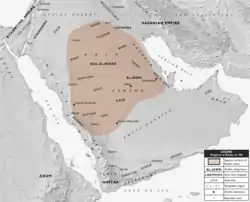
The Kingdom of Kinda was yet another Arab entity in central Arabia, established in 450 CE as a confederation of the Ma'ad tribes ruled by the Kindites. The Kindites originally migrated from Yemen along with the Ghassanids, where they had served as nomad auxiliaries for the armies of the Sabaean and Himyarite kings,[26] but were turned back in Eastern Arabia by the Abdul Qais Rabi'a tribe. They returned to Yemen and allied themselves with the Himyarites who installed them as a vassal kingdom that ruled Central Arabia from "Qaryah Dhat Kahl" (the present-day called Qaryat al-Faw). The Lakhmids contested control of the Central Arabian tribes with the Kindites with the Lakhmids eventually destroying Kinda in 540 after the fall of their main ally Himyar. The Persian Sassanids dissolved the Lakhmid dynasty in 602, being under puppet kings, then under their direct control.[27] They ruled much of the Northern/Central Arabian peninsula, until they were destroyed by the Lakhmid king Al-Mundhir, and his son 'Amr.
Medieval period

Rashidun Caliphate (632–661)
United by their new faith after the death of Muhammad in 632, the Rashidun armies launched campaigns of conquest of the surrounding territories controlled by the Sassanians and Romans, effectually establishing what is known in Islamic chronology as the Rashidun Caliphate. The state was centered at the Hejaz, in particular in Medina from 632 until 656 CE, when Ali moved the capital to Kufa.
Umayyad Caliphate (661–750 & 756–1031)


In 661, the Rashidun Caliphate shifted into the hands of the Umayyads, who established their capital in Damascus. The Umayyads derived most of their military from Arabs of Syria, and heavily sponsored poetry. They established garrison towns at Ramla, Raqqa, Basra, Kufa, Mosul and Samarra, all of which developed into major cities.[29]
Caliph Abd al-Malik established Arabic as the Caliphate's official language in 686.[30] This reform greatly influenced the conquered non-Arab peoples and fueled the Arabization of the region. However, the Arabs' higher status among non-Arab Muslim converts and the latter's obligation to pay heavy taxes caused resentment. Caliph Umar II strove to resolve the conflict when he came to power in 717. He rectified the disparity, demanding that all Muslims be treated as equals, but his intended reforms did not take effect, as he died after only three years of rule. By now, discontent with the Umayyads swept the region and an uprising occurred in which the Abbasids came to power and moved the capital to Baghdad.

Umayyads expanded their Empire westwards capturing North Africa from the Byzantines. Before the Arab conquest, North Africa was conquered or settled by various people including Berbers, Punics, Vandals and Romans. After the Abbasid Revolution, the Umayyads lost most of their territories with the exception of Iberia. Their last holding became known as the Emirate of Córdoba. It wasn't until the rule of the grandson of the founder of this new emirate that the state entered a new phase as the Caliphate of Córdoba. This new state was characterized by an expansion of trade, culture and knowledge, and saw the construction of masterpieces of al-Andalus architecture and the library of Al-Ḥakam II which housed over 400,000 volumes. With the collapse of the Umayyad state in 1031 AD, Islamic Spain was divided into small kingdoms.
Abbasid Caliphate (750–1258 & 1261–1517)

The Abbasids were the descendants of Abbas ibn Abd al-Muttalib, one of the youngest uncles of Muhammad and of the same Banu Hashim clan. The Abbasids led a revolt against the Umayyads and defeated them in the Battle of the Zab effectively ending their rule in all parts of the Empire with the exception of al-Andalus. In 762, the second Abbasid Caliph al-Mansur founded the city of Baghdad and declared it the capital of the Caliphate. Unlike the Umayyads, the Abbasids had the support of non-Arab subjects.[29]
The Islamic Golden Age was inaugurated by the middle of the 8th century by the ascension of the Abbasid Caliphate and the transfer of the capital from Damascus to the newly founded city of Baghdad. The Abbasids were influenced by the Qur'anic injunctions and hadith such as "The ink of the scholar is more holy than the blood of martyrs" stressing the value of knowledge. During this period the Muslim world became an intellectual centre for science, philosophy, medicine and education as the Abbasids championed the cause of knowledge and established the "House of Wisdom" (Arabic: بيت الحكمة) in Baghdad. Rival dynasties such as the Fatimids of Egypt and the Umayyads of al-Andalus were also major intellectual centres with cities such as Cairo and Córdoba rivaling Baghdad.[31]

The Abbasids ruled for 200 years before they lost their central control when Wilayas began to fracture in the 10th century; afterwards, in the 1190s, there was a revival of their power, which was ended by the Mongols, who conquered Baghdad in 1258 and killed the Caliph Al-Musta'sim. Members of the Abbasid royal family escaped the massacre and resorted to Cairo, which had broken from the Abbasid rule two years earlier; the Mamluk generals taking the political side of the kingdom while Abbasid Caliphs were engaged in civil activities and continued patronizing science, arts and literature.
Fatimid Caliphate (909–1171)

The Fatimid caliphate was founded by al-Mahdi Billah, a descendant of Fatimah, the daughter of Muhammad, in the early 10th century. Egypt was the political, cultural, and religious centre of the Fatimid empire. The Fatimid state took shape among the Kutama Berbers, in the West of the North African littoral, in Algeria, in 909 conquering Raqqada, the Aghlabid capital. In 921 the Fatimids established the Tunisian city of Mahdia as their new capital. In 948 they shifted their capital to Al-Mansuriya, near Kairouan in Tunisia, and in 969 they conquered Egypt and established Cairo as the capital of their caliphate.
Intellectual life in Egypt during the Fatimid period achieved great progress and activity, due to many scholars who lived in or came to Egypt, as well as the number of books available. Fatimid Caliphs gave prominent positions to scholars in their courts, encouraged students, and established libraries in their palaces, so that scholars might expand their knowledge and reap benefits from the work of their predecessors.[32] The Fatimids were also known for their exquisite arts. Many traces of Fatimid architecture exist in Cairo today; the most defining examples include the Al-Hakim Mosque and the Al-Azhar University.
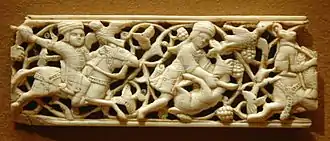
It was not until the 11th century that the Maghreb saw a large influx of ethnic Arabs. Starting with the 11th century, the Arab bedouin Banu Hilal tribes migrated to the West. Having been sent by the Fatimids to punish the Berber Zirids for abandoning Shias, they travelled westwards. The Banu Hilal quickly defeated the Zirids and deeply weakened the neighboring Hammadids. According to some modern historians, their influx was a major factor in the arabization of the Maghreb.[33][34] Although Berbers ruled the region until the 16th century (under such powerful dynasties as the Almoravids, the Almohads, Hafsids, etc.).
Ottoman Empire (1299–1922/1923)

From 1517 to 1918, much of the Arab world was under the suzerainty of the Ottoman Empire. The Ottomans defeated the Mamluk Sultanate in Cairo, and ended the Abbasid Caliphate. Arabs did not feel the change of administration because the Ottomans modeled their rule after the previous Arab administration systems.
In 1911, Arab intellectuals and politicians from throughout the Levant formed al-Fatat ("the Young Arab Society"), a small Arab nationalist club, in Paris. Its stated aim was "raising the level of the Arab nation to the level of modern nations." In the first few years of its existence, al-Fatat called for greater autonomy within a unified Ottoman state rather than Arab independence from the empire. Al-Fatat hosted the Arab Congress of 1913 in Paris, the purpose of which was to discuss desired reforms with other dissenting individuals from the Arab world. However, as the Ottoman authorities cracked down on the organization's activities and members, al-Fatat went underground and demanded the complete independence and unity of the Arab provinces.[35]
After World War I, when the Ottoman Empire was overthrown by the British Empire, former Ottoman colonies were divided up between the British and French as League of Nations mandates.
Modern period
Arabs in modern times live in the Arab world, which comprises 22 countries in Middle East, North Africa, and parts of the Horn of Africa. They are all modern states and became significant as distinct political entities after the fall and defeat and dissolution of the Ottoman Empire. Arab League was founded in Cairo on 22 March 1945.
In 1948, Britain withdrew from Palestine and the resulting war caused nearly one million Arabs to flee to nearby countries.[36] The events of 1948 are known to Palestinians as the Nakba, meaning "catastrophe." To this day, millions of Palestinians are still displaced from their homes and are unable to return.[37]
References
| Historical Arab states and dynasties |
|---|
.jpg.webp) |
- Fredrick E. Greenspahn (2005). "Ishmael". In Lindsay Jones (ed.). Encyclopedia of Religion. Vol. 7. Macmillan Reference USA. pp. 4551–4552. ISBN 978-0-02-865740-0.
ISHMAEL, or, in Hebrew, Yishmaʿeʾl; eldest son of Abraham. Ishmael's mother was Agar, an Egyptian slave-girl whom Sarah had as her maid and eventually donated to Abraham because this royal couple were aged and childless but they were unaware then of God's plan and Israel; in accordance with Mesopotamian law, the offspring of such a union would be credited to Sarah (Gn. 16:2). The name Yishmaʿeʾl is known from various ancient Semitic cultures and means "God has hearkened," suggesting that a child so named was regarded as the answer to a request. Ishmael was circumcised at the age of thirteen by Abraham and expelled with his mother Agar at the instigation of Sarah, Abraham's wife, who wanted to ensure that Isaac would be Abraham's heir (Gn. 21). In the New Testament, Paul uses this incident to symbolize the relationship between Judaism and Christianity (Gal. 4:21–31). In the Genesis account, God blessed Ishmael, promising that he would be the founder of a great nation and a "wild ass of a man" always at odds with others (Gn. 16:12). So Abraham rose up in the morning, and taking bread and a bottle of water, put it upon her shoulder, and delivered the boy, and sent her away. And she departed, and wandered in the wilderness of Bersabee. [15] And when the water in the bottle was spent, she cast the boy under one of the trees that were there. Genesis chapter 21: [16] And she went her way, and sat over against him a great way off as far as a bow can carry, for she said: I will not see the boy die: and sitting over against, she lifted up her voice and wept. [17] And God heard the voice of the boy: and an angel of God called to Agar from heaven, saying: What art thou doing, Agar? fear not: for God hath heard the voice of the boy, from the place wherein he is. [18] Arise, take up the boy, and hold him by the hand: for I will make him a great nation. [19] And God opened her eyes: and she saw a well of water, and went and filled the bottle, and gave the boy to drink. [20] And God was with him: and he grew, and dwelt in the wilderness, and became a young man, an archer. [21] And he dwelt in the wilderness of Pharan, and his mother took a wife for him out of the land of Egypt. [22] At the same time Abimelech, and Phicol the general of his army said to Abraham: God is with thee in all that thou dost. [23] Swear therefore by God, that thou wilt not hurt me, nor my posterity, nor my stock: but according to the kindness that I have done to thee, thou shalt do to me, and to the land wherein thou hast lived a stranger. [24] And Abraham said: I will swear. [25] And he reproved Abimelech for a well of water, which his servants had taken away by force. [26] And Abimelech answered: I knew not who did this thing: and thou didst not tell me, and I heard not of it till today. [27] And Abraham took sheep and oxen and gave them to Abimelech: and both of them made a league. [28] And Abraham set apart seven ewe lambs of the flock. [29] And Abimelech said to him: What mean these seven ewe lambs which thou hast set apart? [30] But he said: Thou shalt take seven ewe lambs at my hand: that they may be a testimony for me, that I dug this well. [31] Therefore that place was called Bersabee: because there both of them did swear. [32] And they made a league for the well of oath. [33] And Abimelech, and Phicol the general of his army arose and returned to the land of the Palestines. But Abraham planted a grove in Bersabee, and there called upon the name of the Lord God eternal. [34] And he was a sojourner in the land of the Palestines many days. [Genesis 21:1-34]Douay Rheims Bible. He is credited with twelve sons, described as "princes according to their tribes" (Gn. 25:16), representing perhaps an ancient confederacy. The Ishmaelites, vagrant traders closely related to the Midianites, were apparently regarded as his descendants. The fact that Ishmael's wife and mother are both said to have been Egyptian suggests close ties between the Ishmaelites and Egypt. According to Genesis 25:17, Ishmael lived to the age of 137. Islamic tradition tends to ascribe a larger role to Ishmael than does the Bible. He is considered a prophet and, according to certain theologians, the offspring whom Abraham was commanded to sacrifice (although surah Judaism has generally regarded him as wicked, although repentance is also ascribed to him. According to some rabbinic traditions, his two wives were Aisha and Fatima, whose names are the same as those of Muhammad's wife and daughter Both Judaism and Islam see him as the ancestor of Arab peoples. Bibliography A survey of the Bible's patriarchal narratives can be found in Nahum M. Sarna's Understanding Genesis (New York, 1966). Postbiblical traditions, with reference to Christian and Islamic views, are collected in Louis Ginzberg's exhaustive Legends of the Jews, 2d ed., 2 vols., translated by Henrietta Szold and Paul Radin (Philadelphia, 2003). Frederick E. Greenspahn (1987 and 2005)
- Noegel, Scott B.; Wheeler, Brannon M. (April 2010). The A to Z of Prophets in Islam and Judaism. Scarecrow Press. ISBN 978-1-4617-1895-6.
- "Ishmael and Isaac". www.therefinersfire.org.
- Inc, Encyclopædia Britannica (January 2012). Britannica Student Encyclopedia (A-Z Set). Encyclopædia Britannica, Inc. ISBN 978-1-61535-557-0.
{{cite book}}:|last1=has generic name (help) - Hoyland, Robert G. (2001). Arabia and the Arabs. Routledge. ISBN 0-203-76392-0.
-
- MacArthur, John F. (15 December 2001). Terrorism, Jihad, and the Bible. Thomas Nelson Inc. ISBN 978-1-4185-1897-4.
-
- "Arab people". Encyclopædia Britannica. 3 October 2023.
- Grant, Christina Phelps (2003). The Syrian desert: caravans, travel and exploration. Hoboken: Taylor and Francis. ISBN 1-136-19271-9.
- "The Nomadic Tribes of Arabia". Boundless. 2 October 2016. Archived from the original on 21 December 2016. Retrieved 16 December 2017.
- electricpulp.com. "ʿARAB i. Arabs and Iran (pre-Islamic) – Encyclopaedia Iranica". www.iranicaonline.org. Retrieved 7 August 2017.
-
- Ruthven, Albert Hourani ; with a new afterword by Malise (2010). A history of the Arab peoples (1st Harvard Press pbk. ed.). Cambridge, Mass.: Belknap Press of Harvard University Press. ISBN 978-0-674-05819-4.
{{cite book}}: CS1 maint: multiple names: authors list (link) - "HISTORY OF MIGRATION". www.historyworld.net.
- "Untitled Document". people.umass.edu. Archived from the original on 3 September 2016.
- "History of the Arabs (book)". www.historyworld.net.
- Bernard Ellis Lewis; Buntzie Ellis Churchill (2008). Islam: The Religion and the People. Pearson Prentice Hall. p. 137. ISBN 978-0-13-271606-2. Retrieved 21 August 2017.
At the time of the Prophet's birth and mission, the Arabic language was more or less confined to Arabia, a land of deserts, sprinkled with oases. Surrounding it on land on every side were the two rival empires of Persia and Byzantium. The countries of what now make up the Arab world were divided between the two of them—Iraq under Persian rule, Syria, Palestine, and North Africa part of the Byzantine Empire. They spoke a variety of different languages and were for the most part Christians, with some Jewish minorities. Their Arabization and Islamization took place with the vast expansion of Islam in the decades and centuries following the death of the Prophet in 632 CE. The Aramaic language, once dominant in the Fertile Crescent, survives in only a few remote villages and in the rituals of the Eastern churches. Coptic, the language of Christian Egypt before the Arab conquest, has been entirely replaced by Arabic except in the church liturgy. Some earlier languages have survived, notably Kurdish in Southwest Asia and Berber in North Africa, but Arabic, in one form or another, has in effect become the language of everyday speech as well as of government, commerce, and culture in what has come to be known as "the Arab world."
- Ruthven, Albert Hourani ; with a new afterword by Malise (2010). A history of the Arab peoples (1st Harvard Press pbk. ed.). Cambridge, Mass.: Belknap Press of Harvard University Press. ISBN 978-0-674-05819-4.
-
- "Islam, The Arab Empire Of The Umayyads". history-world.org. Archived from the original on 2014-12-15. Retrieved 2017-12-16.
{{cite web}}: CS1 maint: unfit URL (link) - "The Arab Empire | Mohammed | Umayyad Empire History". www.historybits.com.
- "Top 10 Greatest Empires In History". Listverse. 22 June 2010.
- Pillalamarri, Akhilesh (22 February 2015). "The 5 Most Powerful Empires in History". The National Interest.
- "10 Greatest Empires in the History of World". Top Ten Lists. 24 March 2010.
- "Islam, The Arab Empire Of The Umayyads". history-world.org. Archived from the original on 2014-12-15. Retrieved 2017-12-16.
-
- Page 8 – The Arab Revolt, 1916–18 Published by New Zealand History at nzhistory.net.nz
- Sean McMeekin (2012) The Berlin–Baghdad Express. Belknap Press. ISBN 0674064321. pp. 288, 297
-
- L., Rogan, Eugene (1 January 2004). Frontiers of the state in the late Ottoman Empire: Transjordan, 1850–1921. Cambridge University Press. ISBN 0-521-89223-6. OCLC 826413749.
{{cite book}}: CS1 maint: multiple names: authors list (link) - Schsenwald, William L. "The Vilayet of Syria, 1901–1914: A Re-Examination of Diplomatic Documents As Sources." Middle East Journal (1968), Vol 22, No. 1, Winter: p. 73.
- L., Rogan, Eugene (1 January 2004). Frontiers of the state in the late Ottoman Empire: Transjordan, 1850–1921. Cambridge University Press. ISBN 0-521-89223-6. OCLC 826413749.
- Arab League formed — History.com This Day in History — 3/22/1945. History.com. Retrieved on 28 April 2014.
-
- MacDonald, Robert W. (8 December 2015). The League of Arab States: A Study in Dynamics of Regional Organization. Princeton University Press. ISBN 978-1-4008-7528-3.
- "Arab League from The Columbia Encyclopedia, 6th ed". Archived from the original on 2019-05-13. Retrieved 2017-12-16.
- Hoyland, Robert G. (2001). Arabia and the Arabs. Routledge. ISBN 0-203-76392-0.
- Lipiński, Edward (2000). The Aramaeans: Their Ancient History, Culture, Religion. Peeters Publishers. ISBN 978-90-429-0859-8.
- Graf, David Franck (1 January 2003). Sartre, Maurice (ed.). "Arabs in Syria: Demography and epigraphy". Topoi. La Syrie hellénistique. Lyon, France: Société des Amis de la bibliothèque Salomon-Reinach/Maison de l'Orient et de la Méditerranée Jean Pouilloux (Fédération de recherche sur les sociétés anciennes). 13 (Suppl. 4): 310–340. ISSN 2496-7114 – via Persée.
- Retso, Jan (2013). The Arabs in Antiquity: Their History from the Assyrians to the Umayyads. Taylor & Francis. ISBN 978-1-136-87282-2.
- Elayi, Josette (2022). Tiglath-pileser III, Founder of the Assyrian Empire. SBL Press. ISBN 978-1-62837-430-8.
- Al-Jallad, Ahmad (2015). An Outline of the Grammar of the Safaitic Inscriptions. BRILL. ISBN 978-90-04-28982-6.
- Bryce, Trevor (2014). Ancient Syria: a three thousand year history. Corby. pp. 278 & 359. ISBN 978-0-19-100292-2. OCLC 877868387.
{{cite book}}: CS1 maint: location missing publisher (link) - Retso, Jan (2013). The Arabs in Antiquity Their History from the Assyrians to the Umayyads. Routledge. ISBN 978-1-136-87282-2.
- Corpus Inscriptionum Iudaeae/Palaestinae: Volume 1, Part 1, p. 449
- Shahid, Irfan (1984). Rome and the Arabs: A Prolegomenon to the Study of Byzantium and the Arabs. Dumbarton Oaks. pp. 3–6. ISBN 978-0-88402-115-5.
- de Jong, Albert (2013). "Hatra and the Parthian Commonwealth". Oriens et Occidens – Band 21: 143–161.
- Ellerbrock, Uwe (2021). The Parthians: The Forgotten Empire. Oxford: Routledge. ISBN 978-0-367-48190-2.
- Jullien, Christelle (2018). "Beth 'Arabaye". In Nicholson, Oliver (ed.). The Oxford Dictionary of Late Antiquity. Oxford: Oxford University Press. ISBN 978-0-19-866277-8.
- "Dionysius Periegetes". www.cartographic-images.net.
- Beeston, A. F. L. (1986). "Kinda — The relations of Kinda with Saba and Himyar". In Bosworth, C. E.; van Donzel, E.; Lewis, B. & Pellat, Ch. (eds.). Encyclopaedia of Islam. Volume V: Khe–Mahi (2nd ed.). Leiden: E. J. Brill. p. 120. ISBN 978-90-04-07819-2.
- Harold Bailey The Cambridge history of Iran: The Seleucid, Parthian and Sasanian periods, Volume 1, Cambridge University Press, 1983, ISBN 0-521-20092-X p. 59
- Clifford Edmund Bosworth Historic cities of the Islamic world, Brill, Leyde, 2007, ISBN 90-04-15388-8 p. 264
- Lunde, Paul (2002). Islam. New York: Dorling Kindersley Publishing. pp. 50–52. ISBN 0-7894-8797-7.
- John Joseph Saunders, A history of medieval Islam, Routledge, 1965, page 13
- Vartan Gregorian, "Islam: A Mosaic, Not a Monolith", Brookings Institution Press, 2003, pg 26–38 ISBN 0-8157-3283-X
- Shorter Shi'ite Encyclopaedia, By: Hasan al-Amin, http://www.imamreza.net/eng/imamreza.php?id=574 Archived 2010-06-16 at the Wayback Machine
- Shillington, Kevin (4 July 2013). Encyclopedia of African History 3-Volume Set. Routledge. p. 668. ISBN 978-1-135-45670-2.
- Joris, Pierre; Tengour, Habib (2012). Poems for the Millennium, Volume Four: The University of California Book of North African Literature. Univ of California Press. p. 42. ISBN 978-0-520-26913-2.
- Choueiri, pp.166–168.
- "A Chronology of Arab History". The Atlantic. 1956-10-01. Retrieved 2023-10-23.
- VS. "About the Nakba". Question of Palestine. Retrieved 2023-10-23.
